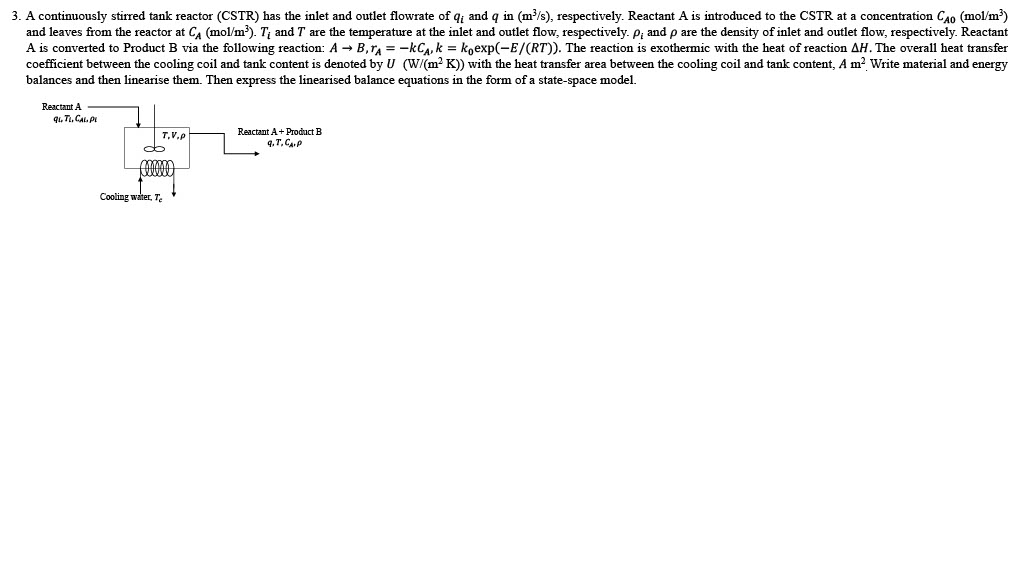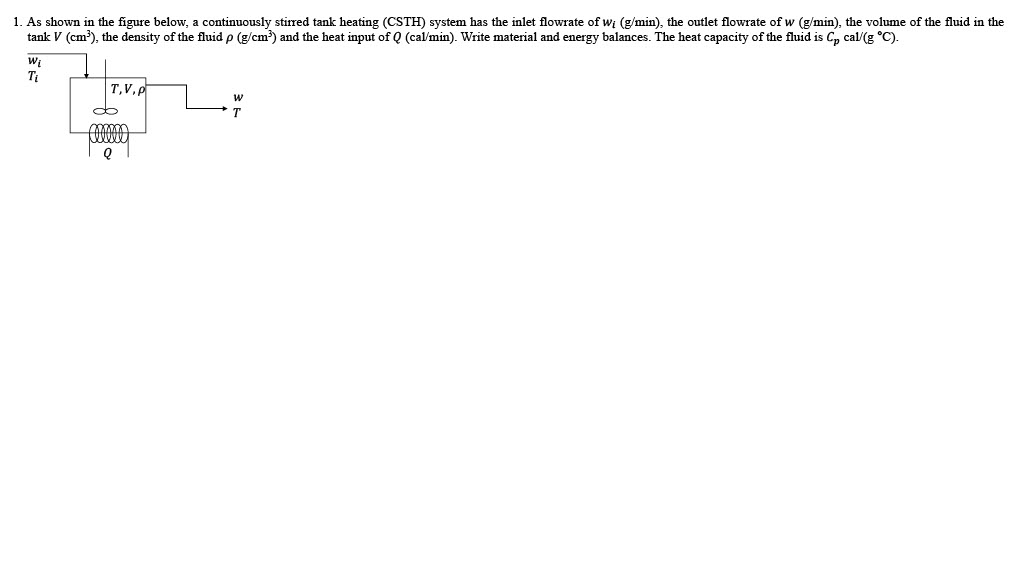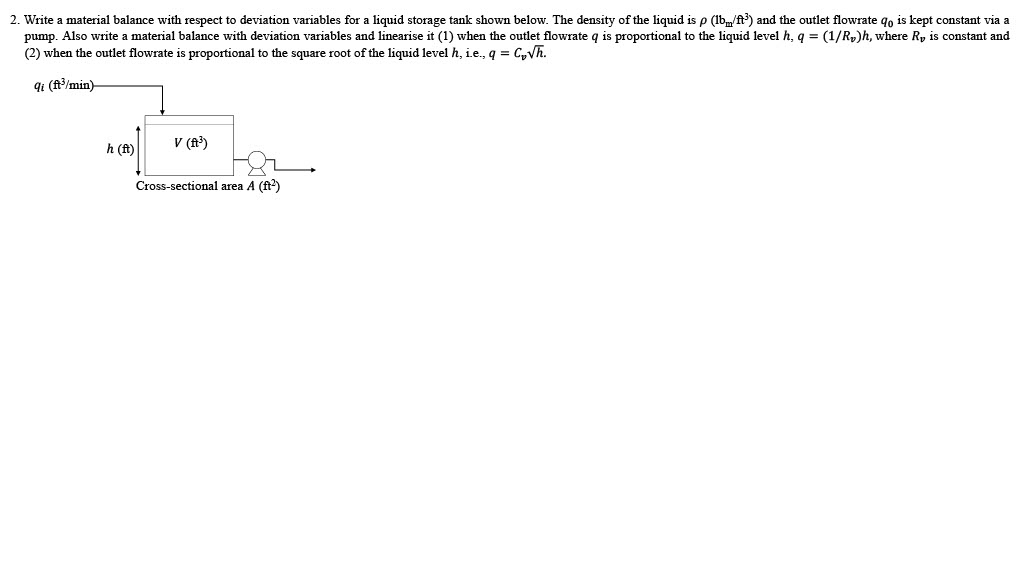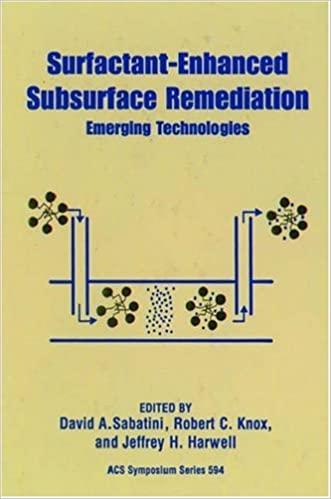Answered step by step
Verified Expert Solution
Question
1 Approved Answer
plz solve them 3. A continuously stirred tank reactor (CSTR) has the inlet and outlet flowrate of qi and q in ( m3/s ), respectively.
plz solve them




3. A continuously stirred tank reactor (CSTR) has the inlet and outlet flowrate of qi and q in ( m3/s ), respectively. Reactant A is introduced to the CSTR at a concentration CA0 (mol/ m3 ) and leaves from the reactor at CA(mol/m3). Ti and T are the temperature at the inlet and outlet flow, respectively. i and are the density of inlet and outlet flow, respectively. Reactant A is converted to Product B via the following reaction: AB,rA=kCA,k=k0exp(E/(RT)). The reaction is exothermic with the heat of reaction H. The overall heat transfer coefficient between the cooling coil and tank content is denoted by U(W/(m2K)) with the heat transfer area between the cooling coil and tank content, A m 2. Write material and energy balances and then linearise them. Then express the linearised balance equations in the form of a state-space model. 1. As shown in the figure below, a continuously stirred tank heating (CSTH) system has the inlet flowrate of wi(g/min ), the outlet flowrate of w (g/min), the volume of the fluid in the tankV(cm3), the density of the fluid (g/cm3) and the heat input of Q(cal/min). Write material and energy balances. The heat capacity of the fluid is Cp cal/(g C). Write a material balance with respect to deviation variables for a liquid storage tank shown below. The density of the liquid is (lbm/ft3) and the outlet flowrate q0 is kept constant via pump. Also write a material balance with deviation variables and linearise it (1) when the outlet flowrate q is proportional to the liquid level h,q=(1/Rv)h, where Rv is constant an (2) when the outlet flowrate is proportional to the square root of the liquid level h, i.e., q=Cvh. Homework - Laplace Transform and Transfer Function 1. Find the Laplace transform of the following functions. (1) f(t)=eat (2) f(t)=tcost (3) f(t)=[1e(t2)/3u(t2))] 2. Find F(s) using the Laplace transforms. (1) 2dtdf(t)+f(t)=3,f(0)=1 (2) 2f(t)+2f(t)+f(t)=Kx(t),f(0)=f(0)=0,(,,K are constant ) 3. Find the initial value of the following function F(s). (Apply the initial value theorem.) F(s)=s(s4s3+s211s+10)4s4+2s214 4. Find the final value of the following F(s) wsing the final value theorem. Prove that the answer is the same as that obtained using the original function f(t). F(s)=s(s+1)1 5. For F(s)=L[f(t)], find f(t). (1) F(s)=s(s4s3+s211s+10)4s4+2s214 (2) F(s)=s2(s2+4s+5)s2+2s10 (3) F(s)=(s+1)(s+2)1e3s 6. Find the solutions of the following differential equations using the Laplace transform and inverse Laplace transform. (1) 4dtdy+3y=2,y(0)=1 (2) y+6y+y+6y=1,y(0)=y(0)=y(0)=0 (3) dtdy=3t+0ty(t)dt,u(0)=1 7. The dynamic behaviour of a process is expressed as the following differential equation. dt2d2y+5dtdy+6y=m(t),y(0)=dtdy(0)=0 where y and m are the output and input of the process, respectively. Find the transfer function of the process. Using the transfer function obtained, find the output response y(t) for the input m(t)=t 8. The dynamic behaviour of a process is expressed as follows: dtdy+y(t)=x(t),y(0)=0 Find the output response y(t) for the input of the process x(t). (u(t) is the unit step function.) (1) x(t)=u(t1) (2) x(t)=u(t1)+u(t2)+u(t3) 3. A continuously stirred tank reactor (CSTR) has the inlet and outlet flowrate of qi and q in ( m3/s ), respectively. Reactant A is introduced to the CSTR at a concentration CA0 (mol/ m3 ) and leaves from the reactor at CA(mol/m3). Ti and T are the temperature at the inlet and outlet flow, respectively. i and are the density of inlet and outlet flow, respectively. Reactant A is converted to Product B via the following reaction: AB,rA=kCA,k=k0exp(E/(RT)). The reaction is exothermic with the heat of reaction H. The overall heat transfer coefficient between the cooling coil and tank content is denoted by U(W/(m2K)) with the heat transfer area between the cooling coil and tank content, A m 2. Write material and energy balances and then linearise them. Then express the linearised balance equations in the form of a state-space model. 1. As shown in the figure below, a continuously stirred tank heating (CSTH) system has the inlet flowrate of wi(g/min ), the outlet flowrate of w (g/min), the volume of the fluid in the tankV(cm3), the density of the fluid (g/cm3) and the heat input of Q(cal/min). Write material and energy balances. The heat capacity of the fluid is Cp cal/(g C). Write a material balance with respect to deviation variables for a liquid storage tank shown below. The density of the liquid is (lbm/ft3) and the outlet flowrate q0 is kept constant via pump. Also write a material balance with deviation variables and linearise it (1) when the outlet flowrate q is proportional to the liquid level h,q=(1/Rv)h, where Rv is constant an (2) when the outlet flowrate is proportional to the square root of the liquid level h, i.e., q=Cvh. Homework - Laplace Transform and Transfer Function 1. Find the Laplace transform of the following functions. (1) f(t)=eat (2) f(t)=tcost (3) f(t)=[1e(t2)/3u(t2))] 2. Find F(s) using the Laplace transforms. (1) 2dtdf(t)+f(t)=3,f(0)=1 (2) 2f(t)+2f(t)+f(t)=Kx(t),f(0)=f(0)=0,(,,K are constant ) 3. Find the initial value of the following function F(s). (Apply the initial value theorem.) F(s)=s(s4s3+s211s+10)4s4+2s214 4. Find the final value of the following F(s) wsing the final value theorem. Prove that the answer is the same as that obtained using the original function f(t). F(s)=s(s+1)1 5. For F(s)=L[f(t)], find f(t). (1) F(s)=s(s4s3+s211s+10)4s4+2s214 (2) F(s)=s2(s2+4s+5)s2+2s10 (3) F(s)=(s+1)(s+2)1e3s 6. Find the solutions of the following differential equations using the Laplace transform and inverse Laplace transform. (1) 4dtdy+3y=2,y(0)=1 (2) y+6y+y+6y=1,y(0)=y(0)=y(0)=0 (3) dtdy=3t+0ty(t)dt,u(0)=1 7. The dynamic behaviour of a process is expressed as the following differential equation. dt2d2y+5dtdy+6y=m(t),y(0)=dtdy(0)=0 where y and m are the output and input of the process, respectively. Find the transfer function of the process. Using the transfer function obtained, find the output response y(t) for the input m(t)=t 8. The dynamic behaviour of a process is expressed as follows: dtdy+y(t)=x(t),y(0)=0 Find the output response y(t) for the input of the process x(t). (u(t) is the unit step function.) (1) x(t)=u(t1) (2) x(t)=u(t1)+u(t2)+u(t3)
Step by Step Solution
There are 3 Steps involved in it
Step: 1

Get Instant Access to Expert-Tailored Solutions
See step-by-step solutions with expert insights and AI powered tools for academic success
Step: 2

Step: 3

Ace Your Homework with AI
Get the answers you need in no time with our AI-driven, step-by-step assistance
Get Started


